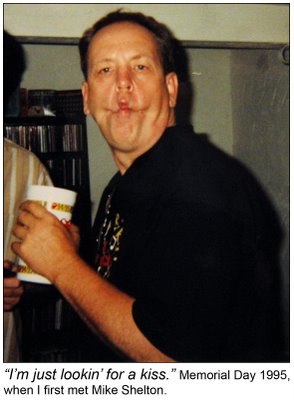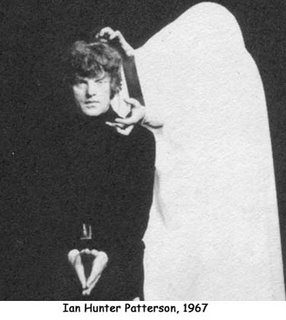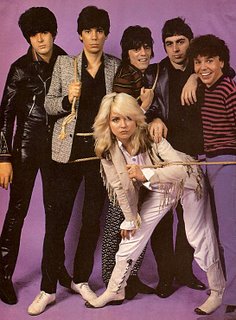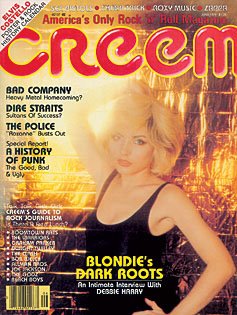 A new record from the New York Dolls is a dicey proposition. 3/5 of the original band are dead, and what they spawned has been so diluted over the decades that trying it again would be like trying to get another cup out of a spent teabag.
A new record from the New York Dolls is a dicey proposition. 3/5 of the original band are dead, and what they spawned has been so diluted over the decades that trying it again would be like trying to get another cup out of a spent teabag.Then Steve Scariano let us know that One Day It Will Please Us To Remember Even This was absolutely great. No, it’s not a New York Dolls record, but it is the best David Johansen solo album ever, and isn’t that reason enough?
Yes.
He goes on to say that “You know if Mike Shelton were here he’d be in everybody’s face, rounds of phone calls, telling us how amazing this record is – go out and buy it, you’ll love it!” Shelton adored David Johansen, seeing him every single time he came to St. Louis, even attending the opening night of Car 54, Where Are You? because he starred in it. Shelton couldn’t convince anyone to see the rotten movie with him, so he went only with his unceasing loyalty to Johansen’s ever-more-curious career moves.
Both Shelton & Scariano are right about the new record: it’s bloody brilliant. Where I disagree with the boys is I do think it’s a New York Dolls album, undoubtedly and unceasingly.
Based on historical review of a 33-year career, Mr. Johansen has always played a character, worn a costume, trotted out a new musical act for his audience. Transvestite proto-punk, BoHo Chic troubadour, New Wave Mick Jagger, lizard lounge act, ancient white bluesman… He has artfully continued the David Bowie-inspired craft of Musical Chameleon while never requiring the PR fanfare of more calculated practitioners like Madonna.
All these musical personas work because Johansen always comes from a musically pure place. His unceasing fascination and precise historical knowledge of all facets of popular music have always guided him. A New York Doll was the first mask he donned, and he was fortunate enough to have a randy glam boys’ glee club willing to go along with the lark. The Dolls profoundly influencing an important sector of rock music was the divine intervention of being in the right place at the right time. Rather than lessen the achievement, it makes the story that much sweeter.
The Dolls were Chapter One, while Buster Poindexter was Chapter 4, and all his characters are important plot points in Johansen’s musical review. Revisiting the New York Doll character is a gripping plot twist, and David is such a passionate, professional performer that I feel bad for even momentarily doubting that he’d do a disservice to the Dolls legacy. He remembers exactly the Dolls recipe: Chuck Berry, Ellie Greenwhich, Greenwhich Village drag queens, comic books, The Beatles, trash & kitsch culture, urban snark, street punk bravado. Using fresh ingredients, this recipe still works in the hands of the master chef.
The 21st Century New York Dolls philosophy is still irreverent, world weary and joyful. Creationist freaks get humorously poked with “Dance Like A Monkey,” my favorite protest song of the year. On “Plenty of Music,” they revisit The Ronnettes and score 10 points for the use of the word “superfluous” in an era-perfect chorus. The rowdy songs (“We’re All In Love,” “Punishing World,”) uplift, the spiritual songs (“Dancing on the Lip of a Volcano,” “Maimed Happiness”) inspire. Johansen’s lyrics are consistently arch, articulate, and snotty. The 3 new guys are top-notch rockers, and with Johansen and Syl Sylvain leading them astray, it all sounds like a band that’s been goofing off and making music for years. It’s all pure, it all rock, I’m so happy it’s in my life.
And it would be an absolute pleasure to have obsessive conversation about the record with Mike Shelton, but I can’t.
August 2004 Mike, his wife Carrie and his teenage daughter Emily were killed in a freak car accident. They were driving home from Beatlefest in Chicago, when a northbound car crossed the median and slammed into them, instantly killing all 5 people involved. An entire family literally went up in flames, and the shock still lingers like the smell of smoke in your clothes days after a bonfire.
Mike Shelton was the hub that held together the spokes of a musical family. The tires had just blown off the bus and we all crashed hard. Only after he disappeared did we finally realize how large that wheel was, and what a driving force he and Carrie were amongst all St. Louis Rock Obsessed.
The night after their tragic deaths, there was an impromptu wake at CBGB’s. Everyone was dazed and drunk, and tears of abject sorrow turned into tears of bittersweet joy as all the musical loves of Mike’s life played overhead… Bowie, The Beatles, The Stones, Mott the Hoople… every track brought Mike back. Everyone could feel Mike in the room. At one point, the lights went down, the Stooges went up to maximum volume, and an abandoned, tribal dance of celebration took place. The greatest moment of sadness was when they played “Michael Picasso.” Ian Hunter wrote the song as a tribute to his late, great friend Mick Ronson. Ronson was not only Shelton’s greatest musical love, but his personal pal. The ironic karma of Ian’s song to Mick becoming Mike’s song was eerily profound, and even Mike himself broke into tears over how painful our sorrow was.
In the days and months after the Lindsey-Shelton family left, each of us encountered Mike. Whether buying into life after death or deeply cynical about the prospect, each of us had undeniable moments of Mike checking in on us. It was always through the odd placement of a song so poignant and pointed that it defied mere coincidence. He used this same form of communication in both life and death, and each time we experienced it, the message was the same: I’m OK, I’m happy, I’ve still got your back.
The public memorial for Mike Shelton was a benefit concert. Iggy Pop and the The Stooges were Mike’s godhead. The Stooges became The Shemps in the hands of Scariano, Bob Trammel and Craig Petty, and a line-up of Mike pals throughout the decades paraded past the stage, being Iggy for a few minutes (earning the chance to do “TV Eye” is one of the greatest moments in my life). The Duck Room donated the space for the night, a film crew recorded all proceedings, and all of Carrie & Mike’s friends and family gathered for a raucous, magical, cathartic celebration. Mike’s actions in life are a lingering lesson in treasuring your family of choice – your friends. Old connections were renewed, new connections were made, and we’re all still a part of Shelton’s song line.
See memorial concert footage here.
 August 2006 The 2nd anniversary of his abrupt exit, so four of us met for brunch before heading to the cemetery to hang around the family headstone. During the meal, Barb suggests that remembering how we each first met Mike would be a nice ceremony.
August 2006 The 2nd anniversary of his abrupt exit, so four of us met for brunch before heading to the cemetery to hang around the family headstone. During the meal, Barb suggests that remembering how we each first met Mike would be a nice ceremony.May 1995 Mike & Carrie always threw a Memorial Day BBQ at their home. One year, Mike gave Scariano specific instructions to bring some “new, cool people” to the party. In a case of mistaken identity that resonated like a whoopee cushion, I was recruited and brought along as one of those “cool people.” Within 10 minutes of meeting Mike, he asked what turned out to be his litmus test question: Do you like Mick Ronson?
“Oh yeah,” I told him. “But actually, I love Ian Hunter even more. To show how warped I am, in junior high, I used to fantasize that I was married to Ian Hunter.” Mike fixed me with smiling eyes, and said in all mock seriousness, “So did I, honey. So did I!” From that moment on, he was my source of all Ian Hunter news, as well as the imp who fed me smokes and drinks when I shouldn’t have, and goaded me into listening to albums that I probably never would have.
August 2006 Nowadays, Scariano has taken over Mike’s role of the person who practically forces me to get certain new records, with One Day It Will Please Us To Remember Even This being the latest of his benevolent commands. And every time I listen to the new Dolls CD, it easily conjures Mike Shelton.
We head out to Memorial Park cemetery, and walk up to the family headstone that’s constantly covered with tokens of honor and remembrance. In front of Mike’s plaque, a CD had been inserted into the dirt, like inserting it into a player. Getting up close, I see it’s the new New York Dolls CD!!!! Turns out Chris left it there a few days earlier; on what would have been Mike’s 56th birthday. Is this not the gift he would want the most?
Yes.
The four of us lounged on the ground in front of the gravestone, as stories, meat cracks and memories of Mike, Carrie & Emily flowed freely. It felt perfectly natural, it felt good. Once back in the car, Scariano did the absolutely natural thing: He rooted in my glovebox and pulled out the new Dolls. Before ever pulling away from the grave site, it cranked out full blast, and roared all the way back home. It was a riotous symphony that allowed for contemplation and sadness. But then that sadness got slapped silly by love and joy and David Johansen basically describing Shelton: “I’m not an artist/I’m a singing, dancing work of art.”
Mike, I love ya, but I can’t miss you if you won’t go away!
Girl, I can’t go away while you’re playing The Dolls!
Mike, this is why I play it everyday.























